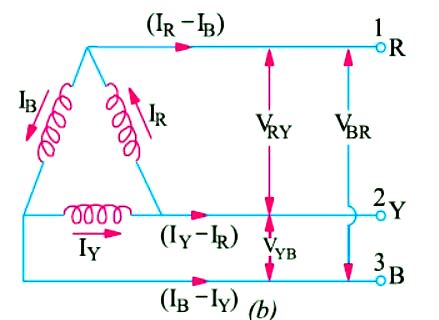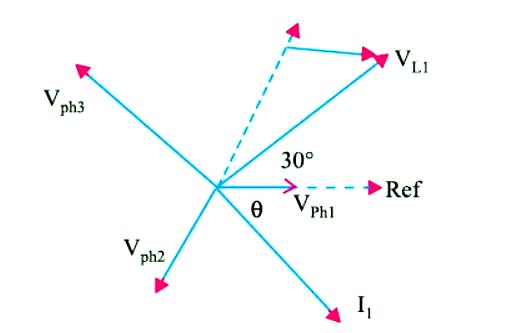Delta Connection Or Mesh Connection
In this form (Delta Connection Or Mesh Connection), of interconnection the dissimilar ends of the three phase winding are joined together i.e. the ‘starting’ end of one phase is joined to the ‘finishing’ end of the other phase and so on as showing in Figure (A).
In other words, the three windings are joined in series to form a closed mesh as shown in Figure (B).
Three leads are taken out from the three junctions as shown as outward directions are taken as positive.
It might look as if this sort of interconnection results in short circuiting the three windings. However, if the system is balanced then sum of the three voltages round the closed mesh is zero, hence no current of fundamental frequency can flow around the mesh when the terminals are open. It should be clearly understood that at any instant, the e.m.f. in one phase is equal and opposite to the resultant of those in the other two phases.

This type of connection (Delta Connection Or Mesh Connection) is also referred to as 3-phase, 3-wire system.
(i) Line Voltages and Phase Voltages
It is seen from Figure (B) that there is only one phase winding completely included between any pair of terminals. Hence, in Δ-connection, the voltage between any pair of lines is equal to the phase voltage of the phase winding connected between the two lines considered. Since phase sequence is R Y B, the voltage having its positive direction from R to Y leads by 120° on that having its positive direction from Y to B. Calling the voltage between lines 1 and 2 as VRY and that between lines 2 and 3 as VYB, we find that VRY lead VYB by 120°. Similarly, VYB leads VBR by 120º as shown in Figure (D). Let VRY = VYB = VBR = line voltage VL. Then, it is seen that VL = Vph.
AdBlock-2

(ii) Line Currents and Phase Currents
It will be seen from Figure (B) that current in each line is the vector difference of the two
phase currents flowing through that line. For example
Current in line 1 is I1 = IR – IB
Current in line 2 is I2 = IY – IR ………………………..Vector difference
Current in line 3 is I3 = IB – IY
Current in line No. 1 is found by compounding IR and IB reversed and its value is given by the diagonal of the parallelogram of Figure (C). The angle between IR and IB reversed (i.e. – IB) is 60°. If IR = IY = phase current Iph (say), then Current in line No. 1 is
I1 = 2 × Iph × cos (60º/2) = 2 × Iph√3/2 = √3Iph
Current in line No. 2 is
I2 = IB – IY ……………….. vector difference = 3Iph and current
in line No. 3 is I3 = IB – IY ∴ Vector difference = 3⋅Iph
Since all the line currents are equal in magnitude i.e.
I1 = I2 – I3 = IL
∴ IL = 3Iph

With reference to Figure (C), it should be noted that
1. line currents are 120º apart ;
2. line currents are 30º behind the respective phase currents ;
3. the angle between the line currents and the corresponding line voltages is (30 + φ ) with the current lagging.
(iii) Power
Power/phase = VphIphcos φ ;
Total power = 3 × VphIphcos φ .
However, Vph = VL and Iph = IL/ 3
Hence, in terms of line values, the above expression for power becomes

where φ is the phase power factor angle.

Read article – Star Connection
Visit NCERTplanet.com for NCERT solutions and Textbook downloads



